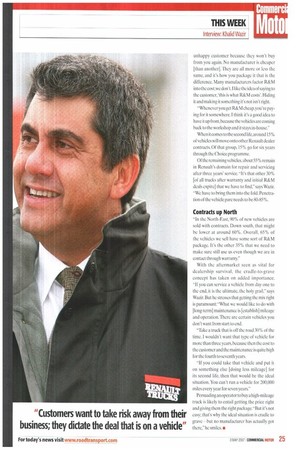From start to finish
Page 24

Page 25

If you've noticed an error in this article please click here to report it so we can fix it.
Renault Truas aftersales director Khalid Wazir talks to Kevin Swallow about the holy grail of
aftersales: handling vehicles from cradle to grave.
Khalid Wazir is an accountant by trade. That's excellent training for aftersales as it is connected to many aspects of a business:new sales, marketing,account management, used vehicles and training to name but a few.
Zimbabwean-born Wazir joined Renault in 2003 from Iveco, where he was head of used vehicles His brief was to review the aftermarket for Renault Trucks and improve the network. "The product coming through was going to be good," he says, "so we needed to get the service levels up to the standard that they should be and in line with the product offering."
This meant improving brand image and lifting the network quality into the top three sooner rather than later. After six months looking over the department he began to adjust the way it worked in terms of standards, customer focus and the gap between customer and manufacturer.
"There is a big gap between customers and manufacturers because they normally deal with the dealers," he says. " Customers like manufacturers caring about them — I always wanted to make sure there was a link [from the manufacturer] to our customers, so we started developing a programme of visiting [customers] with dealers, and sometimes without.
-Our business managers are more focused on visiting customers to make sure they know what Renault Trucks is about from a manufacturer's. as well as a dealer's, perspective."
Customers appreciate direct contact with manufacturers, but the aftermarket is about dealerships delivering a service: "I would like to reach the stage where all the dealerships offer exactly the same service. I don't think any manufacturer has been quite able to get there yet."
Parts availability has to be good too, and Wazir is proud of Renault Trucks' improvement since he joined: "We have a really good logistics system in terms of providing parts to dealers. customers and breakdown services. We're running at 92.7% parts availability within the network; we then look at parts availability through VOR [vehicle off-road] running at 94%."
Compensation for VOR
he afiefIllaYket also covers servicing, breakdowns and vehicle downtime. Operators need to know what they can expect and what compensation plans are in place if a vehicle is off the road.
Wazir says Renault used to pay out for 50-60 days of downtime on its pare of vehicles each month. "We learnt and got better at managing it," he explains. "We want to keep it to zero—we don't want to have downtime, and customers don't want that it either."
Repair and maintenance (R&M) are the basis of Renault's aftersales on first-life (new to three-year-old) vehicles; company representatives will visit a customer to help choose the right vehicle and package.That also means being up front about charges.
We have to get the front end right to help the back end,Wazir points out. "You don't want an
unhappy customer because they won't buy from you again. No manufacturer is cheaper [than another]. They are all more or less the same, and it's how you package it that is the difference. Many manufacturers factor R&M into the cost; we don 11 like the idea of saying to the customer. 'this is what R&M costs'. Hiding it and making it something it's not isn't right.
"Whenever you get R&M cheap,you're paying for it somewhere, think it's a good idea to have it up front, because the vehicles are coming back to the workshop and it stays in-house."
When it comes to the second life,around 15% of vehicles will move onto other Ren.ault dealer contracts. Of that group, 15% go for six years through the Choice programme.
Of the remaining vehicles, about 55% remain in Renault's domain for repair and servicing after three years' service. "It's that other 30% [of all trucks after warranty and initial R&M deals expire] that we have to find," says Wazir. "We have to bring them into the fold. Penetration of the vehicle parc needs to be 80-85%.
Contracts up North "In the North-East, 90% of new vehicles are sold with contracts. Down south, that might be lower at around 60%. Overall, 65% of the vehicles we sell have some sort of R&M package. It's the other 350/n that we need to make sure still use us even though we are in contact through warranty."
With the aftermarket seen as vital for dealership survival, the cradle-to-grave concept has taken on added importance. "If you can service a vehicle from day one to the end, it is the ultimate, the holy grail," says Wazir. But he stresses that getting the mix right is paramount: "What we would like to do with [long-term] maintenance is [establish] mileage and operation. There are certain vehicles you don't want from start to end.
—Take a truck that is off the road 30% of the time. 1 wouldn't want that type of vehicle for more than three years, because then the cost to the customer and the maintenance is quite high for the fourth to seventh years.
"If you could take that vehicle and put it on something else [doing less mileage] for its second life, then that would be the ideal situation. You can't run a vehicle for 200,000 miles every year for seven years."
Persuading an operator to buy a high-mileage truck is likely to entail getting the price right and giving them the right package." But it's not easy; that's why the ideal situation is cradle to grave — but no manufacturer has actually got there," he smiles. in


























































































































































































